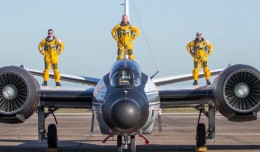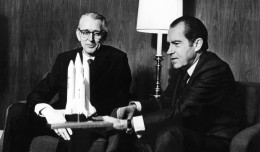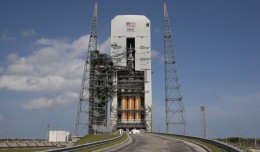The Shuttle Remote Manipulator System (SRMS)
The Shuttle Remote Manipulator System (SRMS) also known as the Canadarm is a mechanical arm for use in orbit to grapple items. It is installed on the port side of the Space Shuttle orbiter’s payload bay edge and can be used to move a payload such as a satellite or cargo container or a truss for the International Space Station from the orbiter to the final position. It can also be used to catch a free-flying payload and bring it into the payload bay of the orbiter. Astronauts used to ride on the arm during long duration external repair missions and installations hence using it as a working platform by attaching their boots to the end of it. Five Canadarms were built by the Canadians and delivered to NASA. One arm was lost in the Challenger accident in 1986. Discovery’s arm was not in the payload bay at the final closing that occurred on December 16, 2011. It may be one of the 500 artifacts of the STS program that Smithsonian plans to store in its repository for our descendents to see. Endeavour’s arm is going back to Canada for display. Atlantis’s arm will be transported to NASA’s Johnson Space Center in Houston for possible use on future spaceflights.
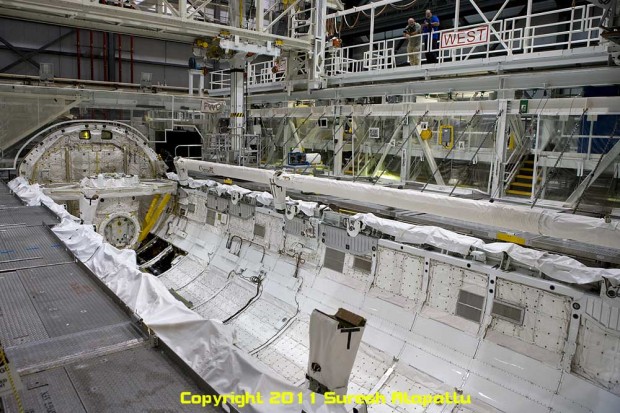
The payload bay of Discovery showing the missing Canadarm from its port side resting position. The object on the starboard side is the attachment to the Canadarm that increases its reach under the orbiter for scanning of the thermal protection system. (Photo by Suresh A. Atapattu/WWW.ATAPATTU.NET)
Draining of the vital fluids of the orbiter
The inside of the payload bay doors are large heat exchangers as the heat generated by the different systems and astronauts have to be vented into Space. The radiators have Freon in them. As part of the transition and retirement all the water and Freon was unloaded.
Auxiliary Power Units (APU)
The orbiters have triple redundancy when it comes to the auxiliary power unit (APU). There are three separate APUs, three hydraulic pumps and three hydraulic systems located in the aft compartment. Each APU is a hydrazine-fueled, turbine-driven power unit that generates mechanical shaft power to drive a hydraulic pump that produces pressure for the orbiter’s hydraulic system. This hydraulic system is used to gimbal the engines, control propellant valves on the engines control, control aero surfaces such as the body flap, the rudder, speed brakes, and the elevons during ascent and decent. In the retired orbiters, the are no APUs. The APU units were extracted from the aft compartment.
Destructive Testing
During the course of the program history, the method of evaluation of the orbiter health was done by the use of non invasive methods. After the lifting of the “do no harm” order, it allowed for the evaluation of critical components by using methods that would lead to damage. Such testing involved removal of items such as wire bundles, actuator and plumbing that was deep inside the orbiter structure. These were items that were only be able to be visually checked during the operations but now they could be cut open and checked to see the effects of prolonged exposure to weightlessness, the survival through the violent phases of spaceflight and the age. All of this testing would have been forbidden if the spacecraft was in flying state.
Final Power down and Payload bay door closing
On the morning of December 16, 2011, the two open payload bay doors of Discovery were closed for the last time. This door closing process involved her spacecraft technicians minding the process from many different angles in coordination with the spacecraft operators on the console at the Launch Control Center. In a slow and meticulous process, the port side door slowly swung to the close position guided by the pulleys attached to the yellow strongbacks attached to the doors itself.
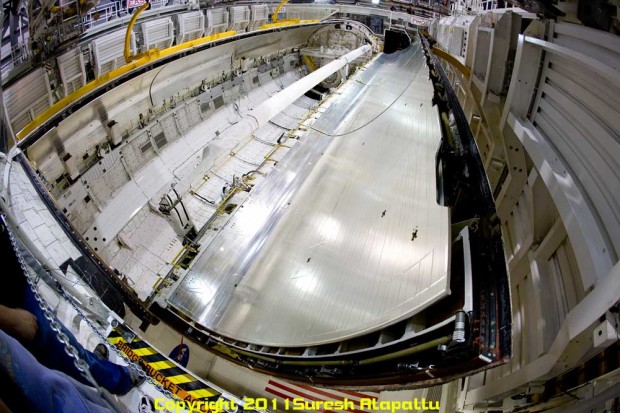
The starboard payload bay door on Discovery swings to the close position for the final time on December 16, 2011. (Photo by Suresh A. Atapattu/WWW.ATAPATTU.NET)
Then, the starboard side door was closed thus sealing the spacecraft for eternity. Since the closing of these doors on Earth require specialized equipment and expertise only present at KSC, it is safe to say that the payload door will remain sealed for a very long time. Opening them without the right equipment and knowledge would be difficult or near impossible. After final payload bay closing, the spacecraft operators completed the final power down of Discovery. It was a somber ceremony as the Multifunction Display Units (MDU) on the flight deck had their data slowly disappear. It was as if her life was slipping away in front of our eyes.
The Space Shuttle Program (SSP) officially ended at 30 days from the “wheels stop” of Space Shuttle orbiter Atlantis on STS-135 (05:57:54 EDT on July 21st2011). Standing on the runway by Discovery, STS-133 Commander Steve Lindsey described bittersweet feelings of bringing home NASA’s most veteran orbiter for its 39th and final time.
“As the minutes pass, I’m actually getting sadder and sadder about this being the last flight and I know all the folks involved with the shuttle program feel the same way.”
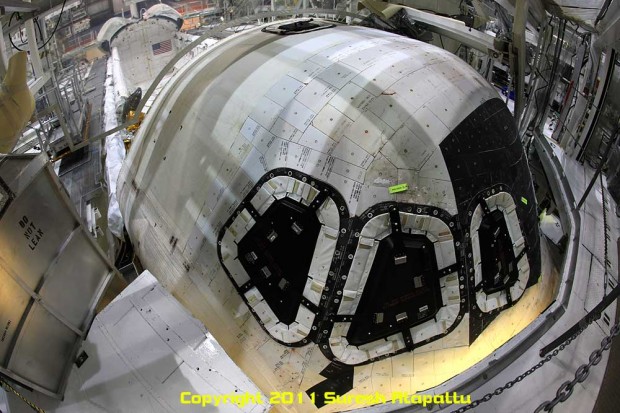
Discovery. (Photo by Suresh A. Atapattu/WWW.ATAPATTU.NET)


